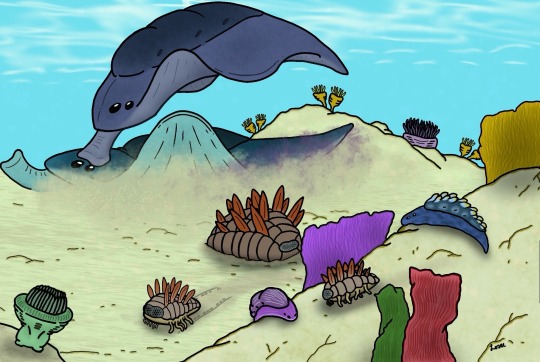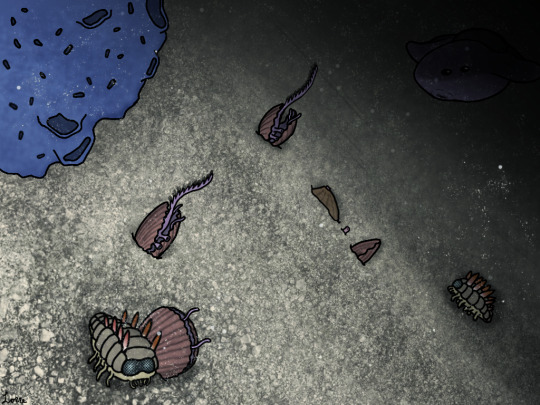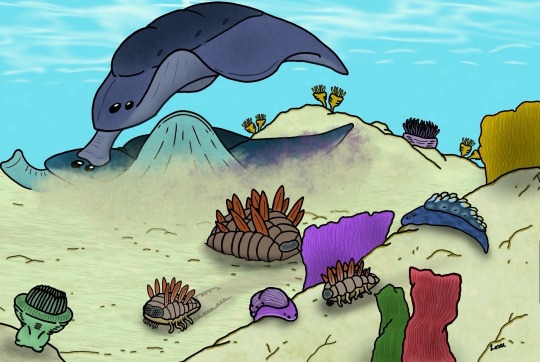(Title Pending)This is the Tumblr page for the Astraea Project! Feel free to ask any questions or discuss the unusual oddities shown here!
Don't wanna be here? Send us removal request.
Text
The Primordial Kraken

They had always known the Ocean existed. They just never ventured to explore it - the Reef was the only place that mattered to them. In the Reef, there was food, shelter, sun & warmth. Nobody ever left the Reef... and those who did, for the most part, never returned.
He never believed it. Just because nobody ever did go back didn't mean nobody could go back; correlation does not imply causation. So on a whim, he swam to the edge, as far out as he could go. He saw curious creatures which weren't in the Reef, strangers with different shapes and smells. But there was never anything threatening or worrisome, while he roamed. Not even in the massive cavern, was there anything which particularly bothered him.
When he saw the Open Sea, however... that was when he felt it.
Awe.
It was big. Bigger than anything he'd ever seen. Bigger than anything he thought could be. It drifted silently by, like a phantom rising from the depths. It was equal parts angel and daemon, monstrous and divine. He felt his mind fraying at the edges simply trying to process the sight before him.
He wanted to run. To get away as fast as possible. But there was another urge... something quiet and reclusive, but still present in the back of his mind.
The urge to go towards it.
For a while, he stayed there, hugging the ground as the entity drifted by, suspended in the distance like a visitor from beyond. Then finally, he turned and swam away.
Nobody ever left the Reef... and for the first time, he understood why...
--------------------------------------
A short little story written for a friend. Happy Spooky Month!
3 notes
·
View notes
Text
The Enydreian Explosion

The Uridachian Period ended not with a bang, but with a whimper. As the primitive creatures of the age began to refine themselves, they evolved the first mouths, the first guts, and the first complex body plans. The evolutionary progression of these multicellular organisms proved to be so devastating to the microbial algal mats of the era, that the algae were forced into decline, only surviving in extreme conditions that couldn't be reached by other organisms. This famine of the natural world prompted the first major extinction event since the Great Oxygenation Catastrophe almost 2 billion years ago, forcing many groups into decline and several into outright extinction.
The survivors, however, were forced to adapt to a new world of scarcity and competition. In the wake of the Global Famine, a new class of organism has evolved - the first predators. The appearance of these predators has prompted the appearance of the first means of protection - body armor, sensory organs, defensive behaviors -, which has forced the predators to further refine their methods to counteract the defenses of their prey. This has triggered an arms race between predator and prey, which has led to an explosion of biodiversity, the likes of which planet Astraea has never seen before, and will likely never see again.
It is now the Enydreian Period, and the ocean is in the midst of revolution. New species have been appearing at an incredible rate, and competition between these various organisms has turned the seas into a battleground. Whatever the outcome of this period of rapid evolution, the face of life on Astraea will forever be changed from it...
40 notes
·
View notes
Text
The Last Sclanedomite

Once upon a time, the most complex organism on Astraea was a species of photosynthetic Parvaean. It was one of the many species of Brittle Shiny which drifted amongst the currents, taking in siliceous minerals from the water and using them to develop a glasslike cell wall known as a frustule. This means of building a body eventually became co-opted to allow these Parvaeans to form simple colonies by linking their bodies together. These weren’t true multicellular organisms, but they proved to be much more efficient compared to growing alone.
Among these species was Fragilampsi turrificator, a species which pioneered creating the first biological formations visible to the naked eye. This species formed lattice-like colonies together, creating massive, rock-like formations of glass and microorganisms; since their discovery, these were known as Sclanedomites, from the Polish phrase for “towers of glass”. The earliest sclanedomites were commonplace along the intertidal zones of the protocontinents, forming vast reeflike colonies which reached upwards to the skies. In their day, billions of years ago, they covered the land in eerie, monolithic reefs of glass.
The dominion of the sclanedomites began to decline with the Snowball Event, the global ice age which swept across the planet in the wake of Astraea’s Great Oxygenation Event. As glaciers spread across Astraea, many of the once-mighty towers of microorganisms were crushed under the weight of flowing ice, leaving only those near the equator to survive. In addition, during the Snowball Event, the first multicellular organisms evolved - simple amorphous sponges, which filtered water through their bodies and fed on nutrients and plankton. These sponges began to proliferate, spreading across the world and slowly building reefs of their own, gradually overtaking the niches which were once occupied by the sclanedomites.
In the Uridachian Era, sponge and ramosamorph reefs have nearly fully eclipsed the former majesty of their Parvaean forebears. Now such microbial megastructures have become increasingly rare, found most often in hypersaline waters far-removed from the ocean. The few non-saline refuges like this, though, are gradually becoming overtaken by new reef-builders. This sponge reef has been in existence for easily several decades or more, already showing signs of major development. The massive microbial colonies of phototrophic Brittle Shinies still cling on, but their hold is quickly eroding. Very soon, the last of these ancient structures will crumble to dust, and the Age of the Glass Towers will fade into prehistory.
#speculative biology#speculative evolution#The Astraea Project#Sclanedomites#Uridachian Period#diorama#art
5 notes
·
View notes
Text
Night Life on the Slope

Roughly 300km away from the shore, the shallow, sunlit seas surrounding the continents begin to taper down into deeper waters, trailing down to depths of 3,000m. This is the Continental Slope, a transitionary region where the open ocean meets the coastal shallows. Here, currents flow over the seabed, bringing plankton and sediments along with them. Here, the soft, sandy substrate is too loose and fine for more abundant reef-building sponges; however, there are other organisms which thrive in these environments.
Scattered along the bottom are the protruding heads of Scrimbolos. While they look like clams, it is only its head which protrudes above the surface; the rest of the organism lies within a burrow, which it uses both as shelter and as a means of locomotion. Hidden from sight, these wormlike Taco Slugs form huge colonies, filtering passing plankton from the current with their extendable tongues. Safe they may be from surface predators, however, opportunistic Farm-Hat Taco Slugs occasionally try to dig them out.
But it isn't only Scrimbolos that lay claim to these depths; slowly skittering among them are juvenile Goggle Grubs. These phototrophic creatures normally spend the daytime hours gathering in surface waters, where their algal symbionts can soak up the sun's rays. During the night, however, the more mobile young Grubs migrate down into deeper waters, to sift through softer sediments packed with marine snow and detritus. But where the daytime creatures go, their predators are not far behind; lurking in the darkness at the edge of our view, a Noot Sloop patrols along the slope, searching for any vulnerable creatures hiding in the gloom. These deepwater Sloops usually bear darker coloration than their shallow-water counterparts, likely as a means to blend in better with the surrounding water.
#The Astraea Project#Enydreian Explosion#Diorama#Art#speculative biology#speculative evolution#worldbuilding
17 notes
·
View notes
Text
The Taco Slug

One of a revolutionary new group of multicellular organisms, the Taco Slug is a creature which has proliferated throughout the Uridachian Period.
Unlike the first metazoans on Astraea, Taco Slugs exhibit bilateral symmetry - that is, their bodies are exact mirror-matches when divided lengthwise. This symmetry has developed alongside their motility - these creatures move about on a single, muscular foot, which is coated in microscopic cillia and secretes a slimey substance. This allows Takolimax to stick to and climb most surfaces in their seafloor environments.
Like most metazoans at this time, Taco Slugs consume microorganisms. T. antiqua prefers to consume the microbial mats on shallow seabeds, while the subspecies T. vagnum consumes marine snow in deeper waters. In order to sense both its food and environment, taco slugs have developed a variety of sensory mechanisms to find their way. Two pairs of simple eyespots help surface species sense light, while deep ocean species have developed magnetotactic senses, relying on the magnetic field to sense north. Simple chemical receptors in the skin allow them to "taste" the surrounding water for foreign scents, and they can even sense changes in temperature, to a limited degree.
This active lifestyle has led to some notable adaptations regarding the Taco Slug's bodily functions. The various senses it uses to navigate have led to the development of a simplified nerve ganglion clustered towards the front of the animal, to help it better process the senses it receives. The need for motility has necessitated the evolution of blood - specifically, blood using the protein hemerythrin, which gives its blood a violet coloration. Further, the need to obtain oxygen from the water to facilitate its motility has spurred it to develop gills along its back, protruding from the fleshy lobes which give it its taco-shaped form. The need to protect all these various internal organs has necessitated the development of the first skin pigments, to further shield it from harmful solar radiation.
Taco slugs have been one of the most successful and prolific organisms on Astraea, having spread to most corners of the world's ocean habitats. Ongoing research into just what prompted these various adaptations has been thus far inconclusive, but these creatures seem to be on the verge of dominating most habitats they occupy. Further observations will surely reveal more of their secrets.
#The Astraea Project#Uridachian Period#Taco Slugs#Creature Profile#speculative evolution#speculative biology
7 notes
·
View notes
Text

Given the overwhelmingly positive reaction to this project on Youtube, I figured I'd make a Tumblr blog about the Astraea Project, so I can post lil snippets & updates of my worldbuilding process, as well as little short stories/videos/arts I make while compiling things. If y'all have questions about things, feel free to ask stuff!
9 notes
·
View notes